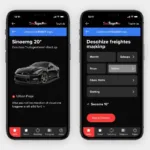OBD2 software can unlock a treasure trove of information about your car, empowering you to diagnose problems, monitor performance, and even customize certain features. But before you can tap into your car’s computer, you need to know how to install OBD2 software correctly. This comprehensive guide will walk you through the process step-by-step, ensuring a smooth and successful installation.
Choosing the Right OBD2 Software
Before diving into the installation process, it’s crucial to select OBD2 software compatible with your needs and device.
Consider these factors when making your choice:
- Operating System: Ensure the software is compatible with your computer, smartphone, or tablet’s operating system (Windows, macOS, Android, iOS).
- Vehicle Compatibility: Check if the software supports your car’s make, model, and year. Some software options are universal, while others are brand-specific.
- Features: Determine what features matter most to you, such as reading and clearing diagnostic trouble codes, viewing live data streams, logging trip information, or customizing car settings.
- User Interface: Opt for software with an intuitive and user-friendly interface that makes navigation and interpretation of data easy, especially if you’re new to OBD2 diagnostics.
- Cost: OBD2 software ranges from free open-source options to paid professional-grade applications. Choose a solution that aligns with your budget and diagnostic needs.
OBD2 Software Installation Methods
Once you’ve chosen the perfect OBD2 software, it’s time to install it.
There are generally two main ways to install OBD2 software:
1. Installing on a Computer (Windows/macOS)
For a more comprehensive diagnostic experience, consider installing OBD2 software on your computer. Here’s a general guide, but always refer to the software’s specific instructions:
- Download the Software: Visit the developer’s website or a trusted software repository to download the installation file.
- Run the Installer: Locate the downloaded file and double-click to start the installation process.
- Follow On-Screen Instructions: The installer will guide you through a series of steps, such as accepting terms and conditions, selecting installation location, and choosing optional components.
- Connect OBD2 Adapter: Once the software is installed, connect your OBD2 adapter to your computer’s USB port.
- Install Drivers (If Needed): Some OBD2 adapters require specific drivers to function correctly. The software might prompt you to install them automatically or provide a link to download them.
- Launch the Software: After installation and driver setup, launch the OBD2 software. It should automatically detect and connect to your OBD2 adapter.
2. Installing on a Smartphone or Tablet (Android/iOS)
Installing OBD2 software on your mobile device offers unmatched convenience and portability. Here’s how:
- Open App Store: Access the Google Play Store (Android) or Apple App Store (iOS) on your device.
- Search for OBD2 Software: Type in “OBD2 software” or the specific app name in the search bar.
- Select and Install: Choose the desired app from the search results and tap the “Install” button.
- Enable Bluetooth (If Needed): Most OBD2 adapters for smartphones communicate via Bluetooth. Enable Bluetooth on your device and pair it with the adapter.
- Launch the App: Once the app is installed, open it and follow the on-screen instructions to connect to your car’s OBD2 port.
Troubleshooting Common Installation Issues
While OBD2 software installation is typically straightforward, you might encounter a few hiccups along the way. Here are some common issues and solutions:
- Software Not Recognizing OBD2 Adapter: Double-check the adapter’s connection to your computer or smartphone. Ensure the adapter is powered on and properly paired if using Bluetooth.
- Driver Conflicts: Outdated or conflicting drivers can hinder communication. Update or reinstall drivers for your OBD2 adapter.
- Firewall or Antivirus Interference: Sometimes, security software might block the OBD2 software from accessing the internet or communicating with the adapter. Temporarily disable your firewall or antivirus during installation and add an exception for the software afterward.
- Compatibility Problems: Ensure your chosen OBD2 software and adapter are compatible with your car’s make, model, year, and OBD2 protocol.
“Always prioritize compatibility when selecting your OBD2 software and adapter. Consulting your car’s manual or a trusted mechanic can save you time and potential headaches.” – John Smith, Senior Automotive Diagnostic Technician
Conclusion
Installing OBD2 software is the gateway to unlocking a wealth of information about your car’s health, performance, and more. By following these installation instructions and troubleshooting tips, you can empower yourself to diagnose issues, monitor vital parameters, and even customize certain features – all from the palm of your hand or the comfort of your computer screen.
Need help with OBD2 diagnostics? Contact our team of experts via WhatsApp at +1(641)206-8880 or email us at [email protected]. We offer 24/7 support to assist you with all your OBD2 needs.

